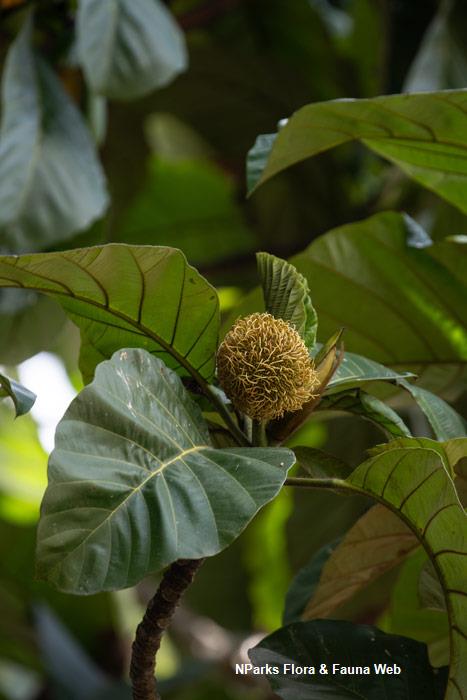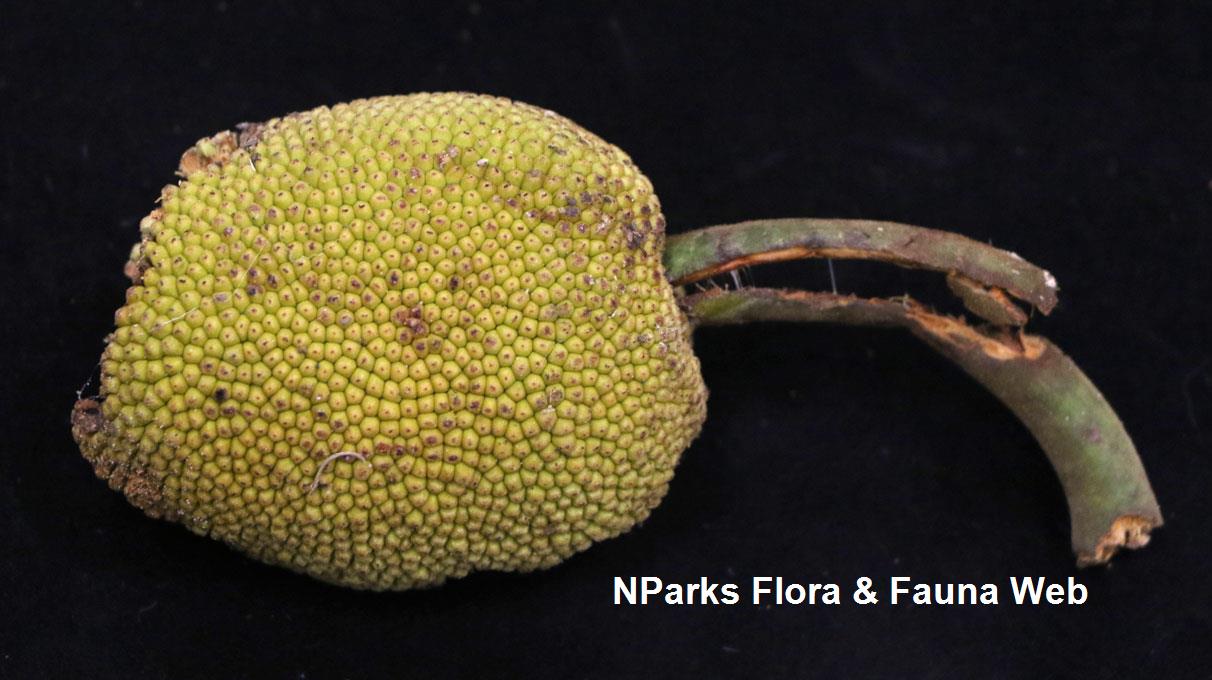
Back
Artocarpus elasticus Reinw. ex Blume
| Family Name: | Moraceae |
| Synonyms: | Artocarpus blumei Trécul, Artocarpus pubescens Blume, Saccus blumei (Trécul) Kuntze, Saccus elasticus (Reinw. ex Blume) Kuntze, Saccus kunstleri (King) Kuntze, |
| Common Name: | Terap, Getah Terup |
Artocarpus elasticus , also known as Terap, is a towering tree native to Singapore. It can reach heights of up to 45 metres. Its fruit are covered in soft spines and emit a distinct rancid odour when ripe. The seeds are encased in a juicy, edible pulp that is said to be sweet tasting and is enjoyed in Southeast Asia.
Name
Classifications and Characteristics
| Plant Division | Angiosperms (Flowering Seed Plants) |
|---|---|
| Plant Growth Form | Tree (Big (>30m)) |
| Lifespan (in Singapore) | Perennial |
| Mode of Nutrition | Autotrophic |
| Maximum Height | 45 m to 65 m |
Biogeography
| Native Distribution | Myanmar, Thailand, Sumatra, Peninsular Malaysia, Singapore, Borneo, Java, Philippines and Lesser Sunda Islands |
|---|---|
| Native Habitat | Terrestrial |
| Preferred Climate Zone | Tropical |
| Local Conservation Status | Native to Singapore (Least Concern (LC)) |
Description and Ethnobotany
| Growth Form | Artocarpus elasticus is a tree that can grow up to 45 m tall, 90 cm trunk diameter, with buttresses up to 3 m tall. Bark is greyish brown, range from smooth to slightly scaly. Tree produces white sap when wounded. |
|---|---|
| Foliage | Leaves are spirally arranged, and simple with rough hairs on both upper and lower surfaces. The leaves are dimorphic, where young plant has deeply lobed leaves and adult tree has elliptical to oblong entire leaves, about 15 – 60 cm long and 10 – 35 cm wide. Lateral venation is prominent on the underside of the leaves and petiole is 4 – 10 cm long. Stipule (6 – 20 cm long) is densely covered with yellowish or reddish brown hairs and wraps almost entirely around the stem (amplexicaul), leaving circular stipule scar when dropped. |
| Flowers | Inflorescences (about 4 – 7.5 cm long) occurs solitary and axillary. Male and female flowers occurs on different individuals. Male flowers have 0.9 mm long stamens and oblong anthers while female flowers have simple or bifid styles which protrude out. |
| Fruit | Fruit is cylindrical (up to 12 cm long and 6 cm wide), with soft recurved spines. Fruit is cream yellow and ripen brownish with a rancid smell. Seeds are covered in white succulent flesh. |
| Cultivation | Grows in full sun. Able to grow in a range of soil from sandy to clay loam. Propagation by seeds. |
| Etymology | The genus epithet Artocarpus comes from the Greek words 'artos', meaning bread and 'karpos', meaning fruit. The species epithet elasticus, in latin, meaning elastic, with reference to its latex. |
| Ethnobotanical Uses | Edible Plant Parts : Edible Fruits, Edible Seeds Food (Fruit or Vegetable): The white fleshy fruiting perianth is edible. Seeds can also be eaten after roasting. Timber & Products: The terap timber is also used mainly for light construction. The bark is used by the aborigines in Sarawak to make ropes and cloths. The latex is used for making bird glue for trapping. Cultural / Religious: Heritage Tree : There are 4 individuals of Artocarpus elasticus listed as Heritage Trees in Singapore. All of which can be found in Fort Canning Park. To find out more about this tree, please visit the Heritage Tree Register. |
Landscaping Features
| Landscape Uses | General, Suitable for Roadsides |
|---|
Plant Care and Propagation
| Light Preference | Full Sun |
|---|---|
| Water Preference | Moderate Water |
| Plant Growth Rate | Moderate |
Foliar
| Mature Foliage Colour(s) | Green |
|---|---|
| Mature Foliage Texture(s) | Leathery |
| Foliar Type | Simple / Unifoliate |
| Foliar Margin | Entire - Wavy / Undulate, Lyrate |
| Typical Foliar Area | Mesophyll ( 45cm2 - 182.25 cm2 ) |
| Leaf Area Index (LAI) for Green Plot Ratio | 3.0 (Tree - Intermediate Canopy) |
Image Repository
Others
| Master ID | 1439 |
|---|---|
| Species ID | 2732 |
| Flora Disclaimer | The information in this website has been compiled from reliable sources, such as reference works on medicinal plants. It is not a substitute for medical advice or treatment and NParks does not purport to provide any medical advice. Readers should always consult his/her physician before using or consuming a plant for medicinal purposes. |

.jpg)
.jpg)






_lowres.jpg)

